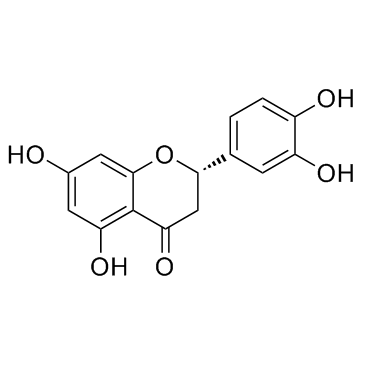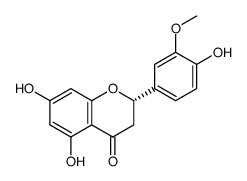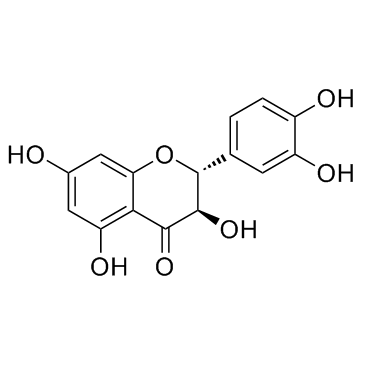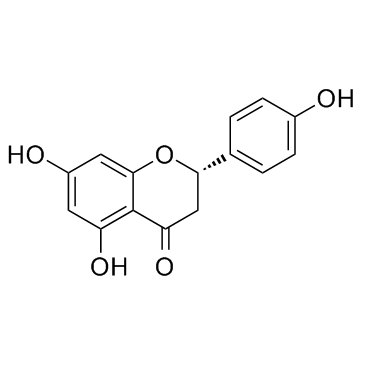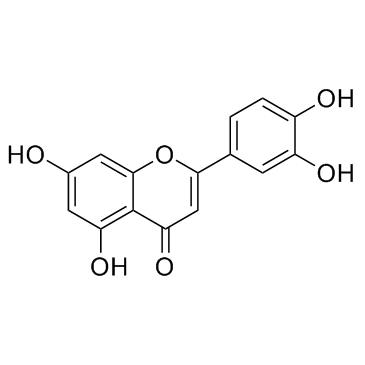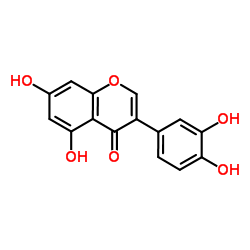552-58-9
| Name | eriodictyol |
|---|---|
| Synonyms |
MFCD00135890
(S)-3',4',5,7-Tetrahydroxyflavanone EINECS 209-016-4 T66 BO EVT&J CR CQ DQ& GQ IQ &&S Form (2S)-2-(3,4-Dihydroxyphenyl)-5,7-dihydroxy-2,3-dihydro-4H-chromen-4-one (S)-2-(3,4-Dihydroxyphenyl)-2,3-dihydro-5,7-dihydroxy-4H-1-benzopyran-4-one 4H-1-Benzopyran-4-one, 2-(3,4-dihydroxyphenyl)-2,3-dihydro-5,7-dihydroxy-, (2S)- Eriodictiol (S)-2-(3,4-Dihydroxyphenyl)-2,3-dihydro-5,7-dihydroxy-4-benzopyrone Eriodictyol |
| Description | Eriodictyol is a flavonoid isolated from the Chinese herb, with antioxidant and anti-inflammatory activity. Eriodictyol induces Nrf2 signaling pathway. |
|---|---|
| Related Catalog | |
| Target |
Human Endogenous Metabolite |
| In Vitro | Eriodictyol is a flavonoid isolated from the Chinese herb, with antioxidant and anti-inflammatory activity[1]. Eriodictyol (20, 40, 80 μM) protects primary cultured cortical neurons against Aβ25-35-induced cytotoxicity and cell apoptosis via the Nrf2/ARE pathway. Eriodictyol (80 μM) induces nuclear expression of Nrf2 and the expression of ARE-regulated genes in primary cultured cortical neurons[2]. |
| In Vivo | Eriodictyol shows protective effect against LPS-induced acute lung injury (ALI). Eriodictyol (30 mg/kg, p.o.) decreases the production of inflammatory cytokines, elevates survival rate, and decreases oxidative stress levels in LPS-induced ALI mice. Eriodictyol inhibits MPO activity and inflammatory neutrophil accumulation in the lung tissues. Eriodictyol treatment also enhances Trx1 expression by upregulating the Nrf2 expression in lung tissues[1]. |
| Cell Assay | Primary cultures of cortical neurons are prepared from day 17 Sprague-Dawley rat embryos and maintained in Neurobasal A medium supplemented with B27. Experiments are performed 7 days after seeding. Aβ25-35 is dissolved in deionized distilled water at a concentration of 1 mM and incubated at 37°C for 7 days to induce its aggregation. Eriodictyol is added at indicated concentrations (20, 40, 80 μM) 2 h prior to Aβ25-35 treatment. Eriodictyol is dissolved in dimethyl sulfoxide (DMSO) at 64 mM as stock solution and diluted in culture medium before use[2]. |
| Animal Admin | Mice[1] Eighty female C57BL/6 mice are anesthetized by an intraperitoneal injection of 150 mg/kg ketamine HCl and 65 µg/kg xylazine hydrochloride. E. coli LPS is instilled intratracheally (25 µg in 50 µL sterile saline) during inspiration. The control mice receive PBS instillation, while the Eriodictyol- and vehicle-treated mice receive Eriodictyol (30 mg/kg, dissolved in PBS) and vehicle (PBS), respectively, orally 2 days prior to the induction of ALI. The mice are then sacrificed by an intravenous injection of thiopental 24 h after the induction of ALI. The thorax is opened and the blood is sampled by cardiac puncture. Simultaneously, three bronchoalveolar lavage (BAL) procedures are performed, each using 0.5 mL normal saline. The blood is centrifuged (2,000 × g, for 10 min at 4°C) and the serum is stored for further processing; the survival curve is then depicted using the Kaplan-Meier method[1]. |
| References |
| Density | 1.6±0.1 g/cm3 |
|---|---|
| Boiling Point | 625.2±55.0 °C at 760 mmHg |
| Melting Point | 270ºC |
| Molecular Formula | C15H12O6 |
| Molecular Weight | 288.252 |
| Flash Point | 241.9±25.0 °C |
| Exact Mass | 288.063385 |
| PSA | 107.22000 |
| LogP | 2.59 |
| Vapour Pressure | 0.0±1.9 mmHg at 25°C |
| Index of Refraction | 1.725 |
| Storage condition | ?20°C |
| Symbol |

GHS07 |
|---|---|
| Signal Word | Warning |
| Hazard Statements | H315-H319-H335 |
| Precautionary Statements | P261-P305 + P351 + P338 |
| Personal Protective Equipment | dust mask type N95 (US);Eyeshields;Gloves |
| Hazard Codes | Xi: Irritant; |
| Risk Phrases | R36/37/38 |
| Safety Phrases | 26-37/39 |
| RIDADR | NONH for all modes of transport |
| WGK Germany | 3 |
| HS Code | 2932999099 |
| HS Code | 2932999099 |
|---|---|
| Summary | 2932999099. other heterocyclic compounds with oxygen hetero-atom(s) only. VAT:17.0%. Tax rebate rate:13.0%. . MFN tariff:6.5%. General tariff:20.0% |


